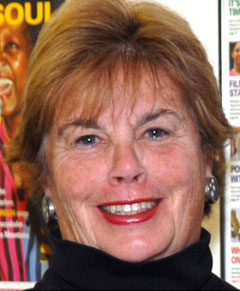Index - April/May 2014 |
|
| Cindy Turcot Grows a Company and Profits for Employees |
| by Allison Teague |
Cindy Turcot, Chief Operating Officer, has tended a crop of employee shareholders who have grown Gardener’s Supply of Burlington and Williston into the nation’s largest marketer of gardening products.
Photo: Jan Doerler
|
It’s rare for anyone to stay at a job for 31 years. It’s even more rare for that person to get up in the morning, feeling she cannot wait to get into the office. Gardener's Supply Company is that sort of workplace. And a big reason why, says Cindy Turcot, Chief Operations Officer (COO) of America’s Gardening Resource, the parent company, is its employee stock option plan.
“I have been fortunate that throughout our evolution, I have been able to work for an amazing founder,” she said, referring to Will Raap, now chairman of the board. Turcot first began in customer service and data entry; but Raap credits Turcot with committing to a new ownership model and making it happen.
The company decided to invest in its employees in 1987, says Turcot, and has relied on Vermont employees’ inherent frugality, independence and creative thinking. “We adopted an Employee Stock Ownership Program (ESOP) that allows all employees to earn stock and share in company profits.” As of December 2009, Gardener's Supply became 100 percent employee-owned.
Turcot has been integral to building the company from its humble beginnings in 1983 to its becoming the nation’s largest catalog-and-web marketer of gardening products and accessories. They now have two garden centers in Williston and Burlington, and millions of customers, with matching revenues and 225 year-round employees.
Continue Reading...
|
|
| Publisher's Message: Spring and Poetry Trumps All |
| by Suzanne Gillis |
|
Spring has always been my favorite season. I love all seasons, but spring to me is nature’s triumph over all things dismal, damp and dreary. And not just because it’s been a difficult and long winter. Nature, like human life, is both painful and also amazingly beautiful. Weeks before spring actually emerges (or bursts), my dreams of it coming are the pulse of life that trumps all reality.
Perhaps it is our dreams or our imagination or our fantasies that give us that sliver of light to get through gray days. Or to outlast catastrophic weather. Or to keep from drowning in despair over human failings and loss. The real trick, I think, is really getting to what beauty is, what happiness is, even if it is fleeting. Or maybe because it is fleeting, and to seize it for all it’s worth.
That’s when poetry becomes essential.
Continue Reading...
|

Sue Gillis,
Vermont Woman Publisher
Photo: Jan Doerler |
|
Vermont Genetic Network Engages Young Scientists Statewide
Part 1 of 3
|
| by Tatiana Schreiber |


Dr. Janet Murray,
VGN's Outreach Director
Photo: Lindsay Raymondjack Photography |
Did you know Vermont women scientists are studying when babies develop a sense of humor? Others are interested in how potassium ion channels are regulated in the hypothalamus. Uniting these diverse, talented, and enthusiastic young scientists is support from the Vermont Genetics Network (VGN). VGN’s mission is to spread a “culture of research” across the state of Vermont. They make accessible and affordable the buildings and science equipment needed to carry out that research.
Directed by Dr. Judith Van Houten, the George H. Perkins Professor of Biology at the University of Vermont, the VGN is funded by a five-year $16.5 million grant from the National Institutes of Health. That’s the largest single investigator grant ever received by UVM.
And although the grant was awarded to Van Houten as principle investigator, she has spread the money and expertise around the state to a remarkable degree. The project develops research facilities and supports graduate research assistants at UVM, but also collaborates with seven Baccalaureate Partner Institutions (BPIs): Castleton State College, Green Mountain College, Johnson State College, Lyndon State College, Middlebury College, Norwich University and Saint Michael's College.
Continue Reading...
|
|
Vermont Filmmakers’ Quest for a People’s History |
| by Amy Lilly |

Filmmaker Nora Jacobson
photo: Jan Doerler
|
In 2005, Norwich filmmaker Nora Jacobson had an idea for a film about Vermont. Her father, a New York playwright, had moved to the state as a young man in 1936 and bought a farm. Nicholas Jacobson was one of many urban artists to populate Vermont over the last century. Jacobson was interested in examining Vermont’s “interesting mix” of “people who have moved here intentionally and integrated themselves,” like her father, “and people who have lived here all their lives with no choice in it,” recalls the 61-year-old.
But soon Jacobson began to think, “One person shouldn’t tell the story of a state.” The filmmaker sat down with a friend, Burlington Free Press film reviewer Susan Green, and the two drew up a list of “everything we could think of that contributed to the way we see the state today.” Jacobson suggested some of these topics to filmmakers she thought might be interested in them. Other directors, hearing of the project, proposed segments exploring their own interests. The list grew.
Over the next nine years, Jacobson cut and stitched together countless reams of footage from her own camera and those of 47—yes, 47—other Vermont filmmakers. The end result is Freedom and Unity: The Vermont Movie.
Continue Reading...
|
|
| Drugs and Poverty a Double Risk for Women |
| by Angela M. Timpone |

Vermont neighbors that Bess O’Brien includes in her film The Hungry Heart about our state’s opiate crisis.
Photos: Carley Stephens-McLaughlin
|
This past January Gov. Peter Shumlin dedicated his State of the State address to what has been called Vermont’s “full-blown opiate crisis.” Opiates include heroin and prescription painkillers (whose euphoria lasts less long than their dangers); death rates from overdoses are high. Shumlin brought passion to this year’s annual speech to Vermonters, highlighting the human cost of drug addiction, a lack of treatment options, and Vermont’s growing drug-related prison population. At the same time, he all but ignored one of the largest drivers of women’s drug addiction until the very end of his address: poverty.
It’s a stereotype to assume there is more drug use among the poor. The majority of the poor, or non-poor, do not use drugs. Vermont earned a ranking as the nation’s “number one state for illicit drugs,” when 15 percent of those surveyed admitted to having “used” in the past month, compared to 4 percent in lowest-ranking Utah. The ranking came from a 2011 survey reported by the Substance Abuse and Mental Health Services Administration and included all substances from marijuana to cocaine.
Continue Reading...
|
|
| Green Mountain Girls Farm: An Agri-Tourism Success |
| by Allison Teague |

“We talk to all our animals,” Laura Olsen (left) and Mari Omland (right) said about their approach to the farming business — picture with a baby mixed breed goat.
Photos courtesy of Green Mountain Girls Farm
|
Mari Omland and Laura Olsen of Green Mountain Girl Farm would count it significant that Vermont chose Ceres, the Roman goddess of agriculture, to overlook Montpelier’s statehouse and surrounding hills. Ceres holds a shock of grain in her arms.
Since the 1700s, Vermonters have been wresting agricultural livelihoods from hilltops and riverine environments. The first farms were self-sufficient and farming families lived on what they raised. Later, sheep farming changed the landscape to open fields of pasture. And now, a new wave of farmers is investing in restoration of the state’s working lands.
Omland and Olsen bought their 40-acre farm in 2007. Nestled atop the hills just south of Paine Mountain in Northfield—and within two miles of I-89, not far from Ceres in Montpelier—the undulating farm and its land is part of 110-acres originally donated to the Vermont Land Trust (VLT) by Thomas and Thelma Osgood in 1993.
Continue Reading...
|
|
| Ride On! Women & Girls Race Mountain Bikes |
| by Sarah Galbraith |

Moxie Spark, Shayla, races her mountain bike at the Catamount Outdoor Family Center in Williston, Vermont.
Photo: The Stride Foundation
|
Standing at the top of a down-sloping rock is one thing. That same view from a bike seat—is entirely another. A rider must assess the path ahead and run through a checklist of pointers: Chin up, elbows out, stand up on the pedals, eyes ahead, weight back. The list goes on. There are risks in mountain biking.
But in fact, Vermont’s women riders are well prepared for rocks in the trail, with a growing roster of programs that support girls’ and women’s mountain bike skills. Mountain biking is the second most popular trail activity nationally, after hiking. And it’s fun, as evidenced by the nearly 40 million national participants each year, according to statistics collected by the Outdoor Foundation. The risks are outweighed by benefits like fitness, fresh air, nature, and community.
Thousands of Vermonters mountain bike, though the actual number is hard to get at, with estimates ranging from a few thousand to 50,000. “The value is huge,” says Craig Whipple, Director of State Parks. “Mountain biking, hiking, and birding are all opportunities for people to get out of doors and connect with nature. Trails provide the doorway to that environment. It’s well-documented that it’s good for our health.” Vermont offers something for every rider, including beginners, families, and kids.
Continue Reading...
|
|








